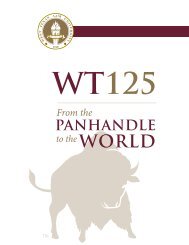The Economic Value of WTAMU Main Report
This report assesses the impact of West Texas A&M University (WTAMU) on the regional economy and the benefits generated by the university for students, taxpayers, and society. The results of this study show that WTAMU creates a positive net impact on the regional economy and generates a positive return on investment for students, taxpayers, and society.
This report assesses the impact of West Texas A&M University (WTAMU) on the regional economy and the benefits generated by the university for students, taxpayers, and society. The results of this study show that WTAMU creates a positive net impact on the regional economy and generates a positive return on investment for students, taxpayers, and society.
Create successful ePaper yourself
Turn your PDF publications into a flip-book with our unique Google optimized e-Paper software.
As shown in Table 3.2, the $44.6 million in gross higher earnings occurs around<br />
Year 13, which is the approximate midpoint <strong>of</strong> the students’ future working<br />
careers given the average age <strong>of</strong> the student population and an assumed<br />
retirement age <strong>of</strong> 67. In accordance with the Mincer function, the gross higher<br />
earnings that accrue to students in the years leading up to the midpoint are less<br />
than $44.6 million and the gross higher earnings in the years after the midpoint<br />
are greater than $44.6 million.<br />
<strong>The</strong> final step in calculating the students’ future benefits stream is to net out<br />
the potential benefits generated by students who are either not yet active in<br />
the workforce or who leave the workforce over time. This adjustment appears in<br />
Column 3 <strong>of</strong> Table 3.2 and represents the percentage <strong>of</strong> the FY 2017-18 student<br />
population that will be employed in the workforce in a given year. Note that the<br />
percentages in the first five years <strong>of</strong> the time horizon are relatively lower than<br />
those in subsequent years. This is because many students delay their entry into<br />
the workforce, either because they are still enrolled at the university or because<br />
they are unable to find a job immediately upon graduation. Accordingly, we<br />
apply a set <strong>of</strong> “settling-in” factors to account for the time needed by students<br />
to find employment and settle into their careers. As discussed in Chapter 2,<br />
settling-in factors delay the onset <strong>of</strong> the benefits by one to three years for<br />
students who graduate with a certificate or a degree and by one to five years<br />
for degree-seeking students who do not complete during the analysis year.<br />
Beyond the first five years <strong>of</strong> the time horizon, students will leave the workforce<br />
for any number <strong>of</strong> reasons, whether death, retirement, or unemployment. We<br />
estimate the rate <strong>of</strong> attrition using the same data and assumptions applied in the<br />
calculation <strong>of</strong> the attrition rate in the economic impact analysis <strong>of</strong> Chapter 2. 35<br />
<strong>The</strong> likelihood <strong>of</strong> leaving the workforce increases as students age, so the<br />
attrition rate is more aggressive near the end <strong>of</strong> the time horizon than in the<br />
beginning. Column 4 <strong>of</strong> Table 3.2 shows the net higher earnings to students<br />
after accounting for both the settling-in patterns and attrition.<br />
Return on investment for students<br />
Having estimated the students’ costs and their future benefits stream, the next<br />
step is to discount the results to the present to reflect the time value <strong>of</strong> money.<br />
For the student perspective we assume a discount rate <strong>of</strong> 4.5% (see below).<br />
Because students tend to rely upon debt to pay for education – i.e. they are<br />
negative savers – their discount rate is based upon student loan interest rates. 36<br />
35 See the discussion <strong>of</strong> the alumni impact in Chapter 2. <strong>The</strong> main sources for deriving the attrition rate are the<br />
National Center for Health Statistics, the Social Security Administration, and the Bureau <strong>of</strong> Labor Statistics. Note<br />
that we do not account for migration patterns in the student investment analysis because the higher earnings<br />
that students receive as a result <strong>of</strong> their education will accrue to them regardless <strong>of</strong> where they find employment.<br />
36 <strong>The</strong> student discount rate is derived from the baseline forecasts for the 10-year Treasury rate published by the<br />
Congressional Budget Office. See the Congressional Budget Office, Student Loan and Pell Grant Programs – April<br />
2018 Baseline. https://www.cbo.gov/system/files?file=2018-06/51310-2018-04-studentloan.pdf.<br />
Discount Rate<br />
<strong>The</strong> discount rate is a rate <strong>of</strong> interest<br />
that converts future costs and benefits<br />
to present values. For example, $1,000<br />
in higher earnings realized 30 years<br />
in the future is worth much less than<br />
$1,000 in the present. All future values<br />
must therefore be expressed in present<br />
value terms in order to compare them<br />
with investments (i.e., costs) made<br />
today. <strong>The</strong> selection <strong>of</strong> an appropriate<br />
discount rate, however, can become an<br />
arbitrary and controversial undertaking.<br />
As suggested in economic theory, the<br />
discount rate should reflect the investor’s<br />
opportunity cost <strong>of</strong> capital, i.e.,<br />
the rate <strong>of</strong> return one could reasonably<br />
expect to obtain from alternative investment<br />
schemes. In this study we assume<br />
a 4.5% discount rate from the student<br />
perspective and a 1.0% discount rate<br />
from the perspectives <strong>of</strong> taxpayers<br />
and society.<br />
Chapter 3: Investment Analysis 51





